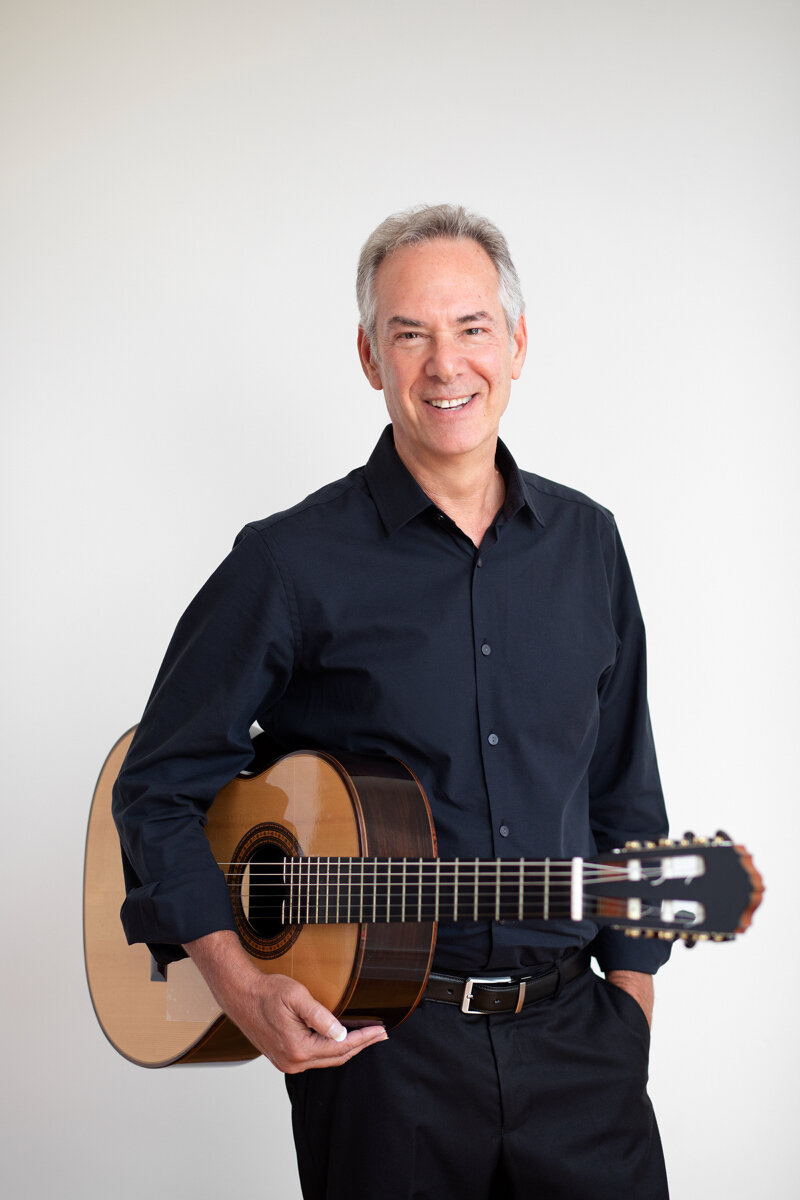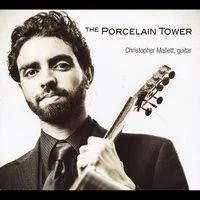Matthew Hinsley was in my first class at Oberlin Conservatory (BM 1996). Before his class, there had never been classical guitar there, so he was in the first class of Conservatory guitar graduates.
While at Oberlin, Matt recorded his first CD. He made a few after that as well. He is one on only three students I have had in over 30 years who could TRULY sing and play at the same time. He gave many recitals performing both traditional and contemporary art song while he self-accompanied.
Matt's second CD, featuring playing and singing both.
In the years that followed the completion of his DMA, though, he turned his attention more to arts management and education. His stewardship of the Austin Classical Guitar Society has become the standard in the industry, the model against which other now measure themselves. In a recent posting at the Society's website, Matt reflected on his years there. He gave me permission to reprint his comments here.
Matt's second CD, featuring playing and singing both.
Matthew writes:
"I’m asked a lot about how I came into this
job. When I speak at conferences, arts leaders are often curious to know
about my past, patrons like to know if this is my “real job,” if this is what I
do “full time,” undergraduate arts students who are staring down the imminent
reality of entering the job market, ask if I was trained in management and
business and seek advice about how they might pursue a similar path.
Before Austin
My interest in nonprofit arts organizations began when
I was an undergraduate student at Oberlin Conservatory of Music. Myself,
and two others, were the very first guitar students ever at Oberlin. My
teacher, Stephen Aron, encouraged me to start a student guitar club because, as
a new department, there were very few resources allocated to classical guitar
guest artists. In three years the Oberlin Guitar Club allocation grew
from $500 to over $2,000, to over $5,000. I quickly learned the power of
well-organized arts presentation, of good writing, of timely requests for
support, and of documentation. And most importantly I learned the joy and
satisfaction of bringing top-quality arts experiences to the community.
Speaking of writing, Steve saw that I could write, and
encouraged me to begin writing not only proposals to the Oberlin Student
Council, but also magazine articles for GFA Soundboard. In all, beginning
at 17 years old, I’d write seven articles for Soundboard in the next 10
years. Writing, be it letters, blog posts, articles, newsletters, ad
copy, grant proposals, reports, articles or books, is easily one of the most
important things I do on a daily basis – and I’m deeply thankful to Steve for
encouraging me in that direction early on.
As a senior at Oberlin, I asked if could write an
optional undergraduate thesis under the supervision of an economics
professor. The resulting paper, Classical Guitar and the Art
Market, begins like this:
“The classical guitar has the ability to appeal to an
incredibly broad spectrum of people. This remarkable quality is the
result of many special features which are truly unique to the guitar. The
features range from the very visual nature of the instrument, to the types of
sounds it produces, to the important associations it has with other types of
music both past and present. The classical guitarist does not have to
compromise artistic quality in order to capitalize on the wealth of musical
heritage associated with the guitar.”
That was spring of 1996, I was 20, and I was about
four months away from Texas.
The First Years
I came to Austin to start
my masters degree in classical guitar performance at UT studying with Adam
Holzman. I spent seven wonderful years with Adam and UT earning my
Masters in 1998 and Doctor of Musical Arts in 2003. Within months of
arriving in Austin, my past caught up with me and I was handed the corporate
documents, and the Board Presidency, of Austin Classical Guitar (ACG).
ACG was a wonderfully small
organization with no articulated budget and operations resembling a small
club. There were monthly meetings featuring local teachers and players
and the occasional guest artist. I quickly learned that “Board President”
was code for “chief volunteer in charge of most everything!”
My first goal was to
stabilize our programming, create a dependable articulated series (that would
soon come to be called our “International Series”), and increase our rate of
communication through a monthly snail mail newsletter. Within months our
ticket sales increased and our membership grew. In just over a year we
had more members than ever before.
In 1998 we added our
Community Concert Series – 20 free concerts per year designed to “reduce or remove
social, economic and geographic barriers to great music.” It was that
year that we began our relationship with the City of Austin.
From 2000 to 2003 I stepped
away from leadership of ACG, but continued to run the Community Concert
Series. It was 2001 that the first iteration of our Educational Outreach
program began at McCallum High School with 15 students. About the time I
finished my DMA in 2003, I returned to leadership as Executive Director at
ACG. A short while later the organization was in a position to pay our
first staff members and take the huge leap of renting our first office!
Within 20 months we would
be able to look back and count John Williams, Pepe Romero, Manuel Barrueco, the
LA Guitar Quartet and many, many more among the artists we’d presented, our
education program had grown to two schools with 100 students, and we had become
one of the largest classical guitar nonprofit organizations ever in the US.
The Last Ten Years
2003 to 2013 has been like
an incredible dream come true. With growth has come many struggles, and
there will be many more, but struggling is part of dreaming big – and trying to
turn those dreams into realities.
Somewhere along the way I learned what I believe
to be my most important lesson. The lesson? That the primary role
of a great classical guitar nonprofit organization is not to play concerts,
teach classes, bring guest artists, or compose new pieces. The primary
role of a great classical guitar nonprofit organization is to serve the
community. To be sure, I’m incredibly proud of this chart and what it
represents, but not because of the money. I’m proud of it because of the
amount of service it represents.
Here are a few of the
things over the past ten years that make me most proud of my team’s work here
at Austin Classical Guitar:
There has been amazing
growth, from 1 to 40 programs, in development and direct support of Austin
school guitar programs. Our programs serve thousands of diverse
students in daily for-credit courses, including programs at Travis County
Juvenile Justice System and Texas School for the Blind and Visually
impaired.
I’m incredibly proud of the
development and 2008 launch of GuitarCurriculum.com, the basis of all Austin
public school class guitar programs and in growing use in more than 400
locations worldwide. If you haven’t been to the site – I encourage you to
visit today -- there's even a video tour!
We’ve had amazing
guest artists including John Williams, Christopher Parkening, LA
Guitar Quartet, Miró Quartet, Assad Duo, Eliot Fisk, Pepe Romero, Los Romeros,
Austin Symphony and so many more – not to mention all the rising stars!
Some of our most exciting moments in presentation have been through extensive
collaborations with amazing groups including: Alamo Drafthouse, AMOA,
ACMC, ASO, ALO, KLRU, KUT, Cactus Cafe, Conspirare and Texas Performing Arts.
We’ve had six major
commissions including: Film Score for “The Unknown” (Avers/Albert
2012), Austin Pictures (Williams 2011), Powerman (Reynolds 2010) and Caprichos
for Eliot Fisk and The Miró Quartet (Balada 2006) – and those don’t include the
incredible piece Joe Williams will write for us this year as our first Composer
in Residence.
We hosted the
largest-ever Guitar Foundation of America International
Convention & Competition (2010)! We’ve had two KLRU TV
Specials: Austin Goes Classical (2010) & Austin
Pictures (2011), and fourteen Austin Critics Table Award Nominations
since 2003, with one Special Award for Excellence in Education (2011)!
And so as I begin my tenth
year as Executive Director of Austin Classical Guitar, I am more excited than
ever about art on the classical guitar and the potential we have to lift
spirits and change lives with our magical, beautiful instrument."
Matt goes on to thank the
many people who played a role in the success of the organization and its
efforts. I asked him about his books, as they were barely mentioned in this
retrospective. He added this:
"I left Oberlin with
two main professional goals: two help improve the way young people are taught
classical guitar in America, and to enhance the way our instrument is presented
to the public. As it turns out I pursued both of those goals avidly.
I've been fortunate to have wonderful young students over the years, have
enjoyed long relationships with many of them; I have had several competition
winners in my studio, with three GFA youth-division finalists, and the 2006
winner. My interest in the field of training young classical guitarists
led me to write a book in 2008 called Classical
Guitar for Young People -- this book is now heading into it's 6th
printing! As Austin Classical Guitar grew I started getting calls and
emails from other classical guitar organizations asking for advice - which I
enjoy giving! I've traveled and assisted arts leaders and boards of
directors from Toronto to Washington DC to San Francisco, and assisted
countless organizations over the phone. What struck me was how consistent
the questions were, and how common the problems, challenges, and management
mistakes were that I was encountering. So this led me to write my second
book in 2010, Creativity to Community: Arts Nonprofit Success One
Coffee at a Time. The word guitar does not appear once in that
book! It's a management book for nonprofit arts leaders about all kinds
of important things from Mission and Vision, to Board Development,
Organizational Structure, Programming, Publicity and, of course,
Fundraising."
Needless to say, I am immensely proud of Matt for all his many accomplishments, for the service he has provided to the Austin community, and to the broader guitar and non-profit communities in general. Wow, Matt, BRAVO!!





